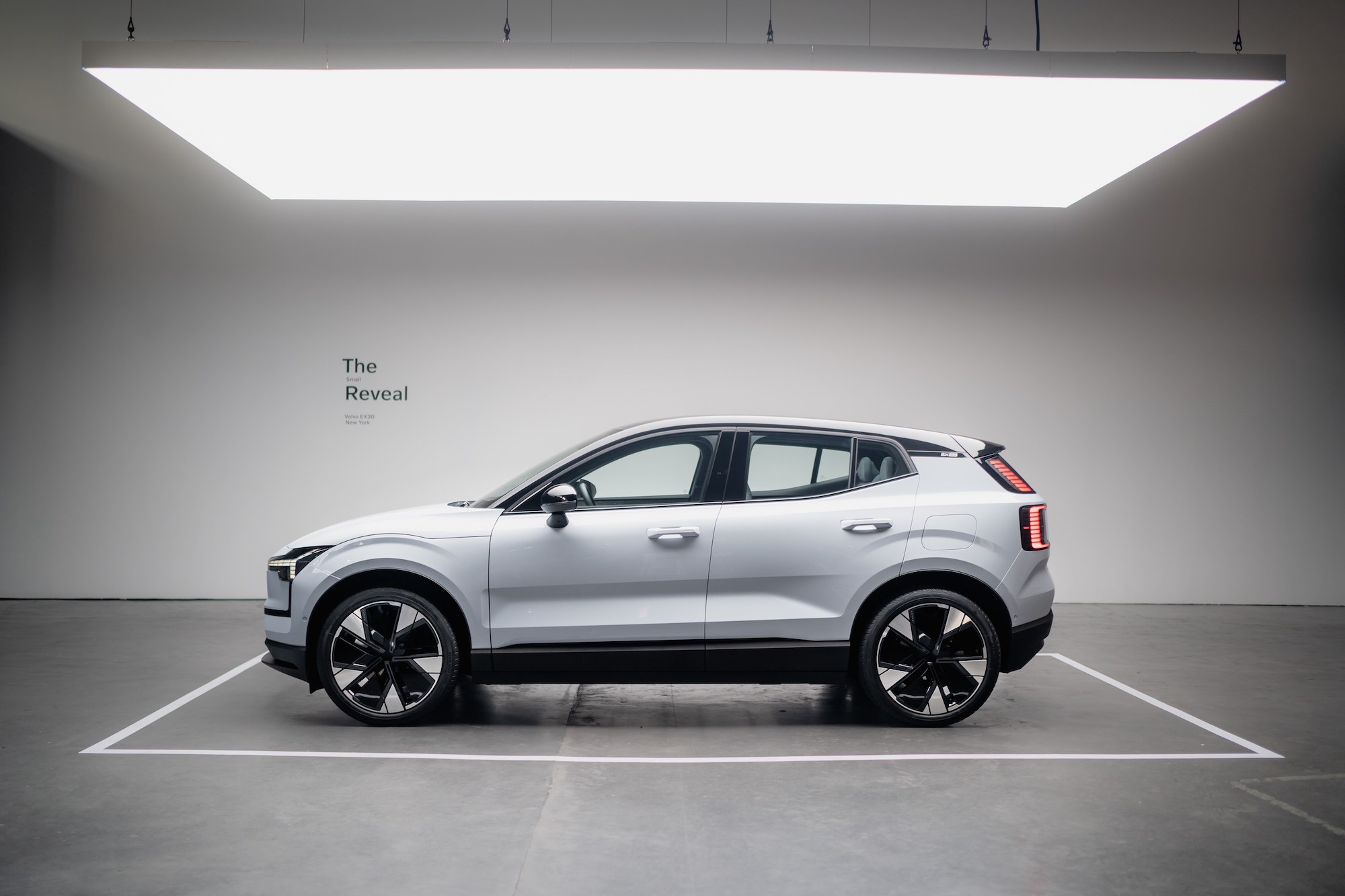World News
Why the all-electric Volvo EX30 is such a big deal on August 1, 2023 at 8:37 pm

Almost a decade ago, Volvo drove into the modern era by going big. Literally. The second-generation XC90 crossover that launched in 2015 helped reset a brand associated with boxy station wagons by offering innovative hybrid engines, striking styling and a big tablet center screen that felt right out of the Tesla playbook.
Now, the car that’s poised to be Volvo’s next big hit is actually pretty small — and affordable, too.
The EX30, which recently made its North American debut in New York, is a car full of firsts. Volvo’s first compact fully electric crossover is its quickest car ever and is outfitted with an innovative, yet cheaper interior made with sustainable materials — a combination the automaker believes is key to turning the EX30 into a mass-volume, mainstream success.
In short, this small car is a big deal for Volvo and a major evolution of the brand. And it’s already making a huge splash.
“The overall reception has been exceeding expectations, multiple times,” David Mele, the EX30’s product manager in the United States, said in an interview. “It’s been remarkably positive. We’re seeing that basically, every market that Volvo operates in is really excited about this car.”
Little car, big deal
A major reason is the EX30’s price tag: It starts at $34,950, instantly making it one of the more affordable EV options in the United States. In a year when electric adoption has seen some ups and downs — some critics worry demand is slowing as EVs pile up on dealer lots — the EX30 will come in well below the average $53,000 price tag these cars command lately.
Very few players exist in America’s affordable EV space right now: There’s the Tesla Model 3 and Model Y, selling like crazy after price cuts and tax rebates; the Chevrolet Bolt, which General Motors reversed course on discontinuing; and a handful of others, like the Kia Niro EV and Hyundai Kona EV and Hyundai Kona Electric. The latter two can easily cross into the $40,000 range at dealer lots.
It’s not that most people aren’t interested in EVs, analysts say, but that they’re turned off by their prices at a time when interest rates are high and the economy faces uncertainty ahead. Data firm AutoPacific found in a recent survey that a price tag below $35,000 is what it would take for many people to flip the switch.
The EX30’s right in that sweet spot, undercutting even Volvo’s next-cheapest car, the compact gas or electric XC40, by a few thousand dollars. The EX30 is about 10 inches smaller than the XC40 and 20 inches smaller than Tesla’s world-beating Model Y crossover.
Previous attempts at compact cars haven’t always gone great for Volvo. Today, its top-selling models in the U.S. are the midsize XC60, followed by the bigger XC90. Past entrants like the compact C30 hatchback and V50 never made a big sales splash, either.
In a lot of ways, the EX30 is risky, but Volvo is banking on that electric powertrain to attract customers it wouldn’t have had before.
Mele said the target EX30 customer is “pre-family” buyers without kids or even “post-family” parents and grandparents. It could be a lot of buyers’ second or third car, or their first EV, and their first Volvo. That’s… a lot of people.
In short, Volvo’s going for mass appeal on this one — something it hasn’t really gone in for terribly often before. “It’s not going to be a niche product,” Mele said. (He declined to discuss sales targets for the EX30.)
Swedish roots, Chinese production
Scale fits with Volvo’s goals of going “half-electric” by 2025 and all-electric by 2030, Mele said. But it’s also a key part of initiatives driven by Volvo’s Chinese parent company, Geely Holding Group. Between Volvo, the more performance-focused Polestar, the British sports car maker Lotus and several EV-focused brands not sold in America like Lynk & Co, Geely is increasingly rising as the Chinese auto conglomerate looking to take over the world — perhaps even without its customers realizing it.
In fact, like just a handful of other cars sold in the U.S. these days, the EX30 will be made in China. That means it won’t be eligible for any U.S. tax credits and that it’s subject to a 27.5% tariff on Chinese-made vehicles — making that price tag even more impressive. (“Anything we have to pay to the government is accounted for in that price,” Mele said, declining to speak on the potential profitability of the car.)
Mele said Volvo is still evaluating where the car will be built over the long term.
While Volvo won’t say anything further officially, it’s plausible that the company could decide to follow the moves of several competitors and put production somewhere in North America. Volvo is already expanding its South Carolina plant to build its flagship EX90 electric crossover. “Our goal, long term, is to build cars where we sell,” Mele said. “That’s both just good from a manufacturing perspective but also cuts down on carbon emissions.”
Other markets aren’t as aggressive on China tariffs, of course. But at a time when European automakers are deeply concerned about lower-cost Chinese cars eating their market share on their home turfs, Volvo is one European brand that could have its kladdkaka and eat it too.
Specs that matter
While Americans have historically been wary of Chinese-made, cars given past perceptions and political tensions, the EX30 could be enough of a deal that it will test just how much we care; the long-held Swedish brand identity might help.
The EX30 offers two battery packs: a 69 kWh nickel-cobalt-manganese unit for North America, and a cheaper, lower-range 51 kWh lithium-iron-phosphate unit for other markets. The EX30 has two powertrain setups. The base model is a single-motor, rear-wheel drive car boasting 272 horsepower and 275 miles of range. That model does zero to 60 mph in a respectable 5.7 seconds. Upgrading to the Twin Motor Performance variant gets dual motors for all-wheel-drive and 422 horsepower, plus a zero to 60 mph time of just 3.4 seconds. No Volvo has ever been that quick from the factory, the company says.
Its 12.3-inch vertical touchscreen, which runs almost all major control interfaces as there’s nothing in front of the driver, much like a Tesla, runs the latest version of Google’s Android operating system. Wireless Apple CarPlay is also standard, as is wireless phone charging, standard 5G connectivity, over-the-air software updates, four USB-C ports, and what Volvo says is the ability to fast-charge from 10% to 80% in 26.5 minutes.
In other words, while it’s small and affordable, it doesn’t seem like some penalty box economy car. And it comes in some fun colors, like Cloud Blue or the especially daring (for Volvo, anyway) Moss Yellow. The EX30 is expected to go on sale next summer.
And while Mele confirmed the EX30 will launch with the standard CCS charging port, Volvo’s models will be able to access Tesla’s Supercharger network with an adapter in 2024, and that plug will be standard from 2025 onward, which could make it even more enticing as someone’s “first EV.” Mele said that’s exactly the goal.
“With this car, we’re sort of democratizing battery electric vehicles,” he said.
Almost a decade ago, Volvo drove into the modern era by going big. Literally. The second-generation XC90 crossover that launched in 2015 helped reset a brand associated with boxy station wagons by offering innovative hybrid engines, striking styling and a big tablet center screen that felt right out of the Tesla playbook. Now, the car
Politics
Netanyahu’s UN Speech Triggers Diplomatic Walkouts and Mass Protests

What Happened at the United Nations
On Friday, Israeli Prime Minister Benjamin Netanyahu addressed the United Nations General Assembly in New York City, defending Israel’s ongoing military operations in Gaza. As he spoke, more than 100 delegates from over 50 countries stood up and left the chamber—a rare and significant diplomatic walkout. Outside the UN, thousands of protesters gathered to voice opposition to Netanyahu’s policies and call for accountability, including some who labeled him a war criminal. The protest included activists from Palestinian and Jewish groups, along with international allies.

Why Did Delegates and Protesters Walk Out?
The walkouts and protests were a response to Israel’s continued offensive in Gaza, which has resulted in widespread destruction and a significant humanitarian crisis. Many countries and individuals have accused Israel of excessive use of force, and some international prosecutors have suggested Netanyahu should face investigation by the International Criminal Court for war crimes, including claims that starvation was used as a weapon against civilians. At the same time, a record number of nations—over 150—recently recognized the State of Palestine, leaving the United States as the only permanent UN Security Council member not to join them.
International Reaction and Significance
The diplomatic walkouts and street protests demonstrate increasing global concern over the situation in Gaza and growing support for Palestinian statehood. Several world leaders, including Colombia’s President Gustavo Petro, showed visible solidarity with protesters. Petro called for international intervention and, controversially, for US troops not to follow orders he viewed as supporting ongoing conflict. The US later revoked Petro’s visa over his role in the protests, which he argued was evidence of a declining respect for international law.

Why Is This News Important?
The Gaza conflict is one of the world’s most contentious and closely-watched issues. It has drawn strong feelings and differing opinions from governments, activists, and ordinary people worldwide. The United Nations, as an international organization focused on peace and human rights, is a key arena for these debates. The events surrounding Netanyahu’s speech show that many nations and voices are urging new action—from recognition of Palestinian rights to calls for sanctions against Israel—while discussion and disagreement over the best path forward continue.
This episode at the UN highlights how international diplomacy, public protests, and official policy are all intersecting in real time as the search for solutions to the Israeli-Palestinian conflict remains urgent and unresolved.
News
Is a Nuclear-Powered Alien Spacecraft Flying Toward Earth?

A mysterious interstellar object speeding through our solar system has reignited debates about extraterrestrial technology — and whether Earth might currently be under quiet observation.
The object, known as 3I/ATLAS, is only the third confirmed interstellar visitor ever detected. Unlike ordinary comets, however, this cosmic traveler has baffled astronomers with its unusual brightness, strange trajectory, and lack of a visible cometary tail. While most scientists cautiously describe it as a natural body, one leading astrophysicist believes something much stranger is at play.

Harvard Scientist’s Bold Claim
Professor Avi Loeb of Harvard University, head of the Galileo Project, has suggested that 3I/ATLAS may in fact be a nuclear-powered alien spacecraft designed to test how humanity would respond to an interstellar visitor. He argues that its flight path is improbably precise, bringing it close to Mars, Venus, and Earth — a pattern highly unlikely to occur by chance.
Loeb also points out that telescope images show a glow inconsistent with ordinary dust behavior. Instead of trailing behind like a comet, the halo-like light appears to extend in unusual ways, sparking debate about whether the object could be emitting energy of its own.
Headed Toward Earth’s Neighborhood
3I/ATLAS is expected to make its closest approach in late 2025, passing near Mars before swinging by the inner solar system. Although Earth itself will be on the opposite side of the Sun when it comes closest, the alignment will still enable space-based observatories to capture sharper data.

Loeb has called on NASA and other agencies to use spacecraft already stationed near Mars or Jupiter — including the Juno mission — to take high-resolution photographs. He believes such efforts could reveal whether the interstellar object is truly natural, or the first technological probe humanity has ever encountered.
Should We Be Worried?
While most astronomers argue caution before jumping to alien conclusions, Loeb insists that scientific openness is key. “If it’s just a comet, we learn something new,” he said. “But if it’s a spacecraft, it would be the most important discovery in human history.”
For now, 3I/ATLAS remains a mysterious speck on astronomers’ charts, drifting closer with each passing day. Whether it proves to be a frozen remnant of another star system or something far more advanced, the interstellar visitor has already succeeded in one mission: reminding us how vast and unpredictable the universe really is.
News
AI Automation Could Cause Up to 20% Unemployment—A Workforce on the Brink

Stark Warning from Anthropic CEO Highlights Rapid Job Displacement Risk
The looming threat of widespread unemployment due to AI automation has sparked intense debate among experts, business leaders, and policymakers. Dario Amodei, CEO of Anthropic—the company behind the influential AI language model Claude—issued a stark warning that has sent shockwaves through corporate America:

“Up to half of all entry-level white collar jobs could disappear within the next one to five years, potentially pushing unemployment rates as high as 20% during this period.”
This dramatic forecast paints a picture of a rapid and unsettling transformation in the workforce, driven by AI technologies that can perform complex cognitive tasks.
Balancing Predictions: Worst-Case Scenarios vs. Moderate Impact
However, this forecast represents one end of a spectrum of expert predictions. While Amodei’s warning highlights the worst-case scenario driven by the swift adoption of AI agents capable of coding, analyzing data, drafting legal documents, and managing workflows around the clock, other analyses suggest a more moderate impact. For example, Goldman Sachs estimates that AI could temporarily displace about 6-7% of U.S. jobs, with unemployment rising by approximately half a percentage point during the adjustment period. Their research anticipates a more gradual transition with a mixture of job disruption and creation.

The Unprecedented Speed and Scope of AI-Driven Job Disruption
The truth likely lies somewhere in between. AI is advancing at unprecedented speed, and the scope of jobs affected spans far beyond blue-collar roles to white-collar positions that required college degrees and years of training. Entry-level roles such as customer service representatives, data entry clerks, junior analysts, and administrative assistants face the greatest near-term risk. Mid-level roles in accounting, marketing, law, and engineering could soon follow, with companies already laying off workers citing AI-driven efficiencies.
Preparing for an AI-Transformed Workforce: Adaptation Is Essential
Ultimately, the AI-driven job transformation is no longer a distant prospect but unfolding now. Whether unemployment spikes to 20% or stabilizes at lower levels depends on many factors, including business adoption rates, government policies, and the ability of workers to reskill. What is certain is that the workforce of tomorrow will look very different from today—and the time to prepare is right now.

 Business3 weeks ago
Business3 weeks agoDisney Loses $3.87 Billion as Subscription Cancellations Surge After Kimmel Suspension

 Entertainment3 weeks ago
Entertainment3 weeks agoWhat the Deletion Frenzy Reveals in the David and Celeste Tragedy

 Entertainment4 weeks ago
Entertainment4 weeks agoABC Suspends ‘Jimmy Kimmel Live!’ Indefinitely After Kirk Remarks

 Entertainment3 weeks ago
Entertainment3 weeks agoExecutive Producer Debut: How Celia Carver Created Festival Hit ‘Afterparty’

 Business4 weeks ago
Business4 weeks agoThe Rise Of Bullsh*t Jobs: Why Gen Z Hates Work

 Health3 weeks ago
Health3 weeks agoRussia Claims 100% Success With New mRNA Cancer Vaccine

 Film Industry4 weeks ago
Film Industry4 weeks agoCan Movie Theaters Steal the Show from Streaming?

 News4 weeks ago
News4 weeks agoBody of Missing Teen Found in Tesla Linked to Musician D4vd






























